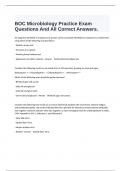BOC Microbiology Practice Exam
Questions And All Correct Answers.
An organism identified as Cryptococcus species can be accurately identified as Cryptococcus neoformans
using which of the following characteristics?
- Positive urease test
- Presence of a capsule
- Positive phenol oxidase test
- Appearance of yellow colonies - Answer Positive phenol oxidase test
Consider the following results on an isolate from a CSF specimen, growing on cornmeal agar:
Blastospores = +, Pseudohyphae = -, Chlamydospores = -, Arthrospores = -
Which of the following tests should be performed next?
- Birdseed agar and urease
- India ink and glucose
- India ink and germ tube
- Germ tube and glucose - Answer Birdseed agar and urease
Consider the following test results on a 21-year-old female student with sore throat, extreme fatigue,
and lymphadenopathy. Lab results indicated that the rapid test for infectious mononucleosis antibodies
was negative. Bacterial cultures were also negative, as were serological tests for antistreptolysin O (ASO),
CMV, Hepatitis B, HIV-1, Influenza A, and Influenza B.
- West Nile Virus
- Epstein-Barr Virus
- Herpes simplex virus
- Rubella - Answer Epstein-Barr Virus
,A technologist performed susceptibility testing via the disk diffusion method on 7H11 plates, on a
specimen from a patient with classic TB. Which of the following are first-line antibiotics that would be
prescribed for treatment of this?
- Isonicotinic acid hydrazine (INH), rifampin, ethambutol
- Ampicillin, penicillin, carbenicillin
- Ampicillin, penicillin, methicillin
- Vancomycin, methicillin, carbenicillin - Answer Isonicotinic acid hydrazine (INH), rifampin, ethambutol
A CSF culture from an immunocompromised patient grew gram-negative coccobacilli on chocolate agar.
Further testing revealed the following:
Motility = -, Indophenol Oxidase = +, MacConkey = no growth
Antibiotic testing showed that it was highly susceptible to penicillin. Which of the following organisms is
most likely present?
- Pseudomonas stutzeri
- Moraxella lacunata
- Acinetobacter spp
- Pseudomonas aeruginosa - Answer Moraxella lacunata
A medical technologist receives a stool specimen on a patient with diarrhea who has just returned from
visiting South America. The patient is suspected of having an infection caused by Vibrio cholerae. Which
of the following media would be best for the identification and recovery of this organism?
- Blood agar
- TCBS agar
- XLD agar
- MacConkey agar - Answer TCBS agar
A gram negative, non-lactose fermenter was recovered from a culture from patient suffering from 2nd
degree burns. Which of the following tests would best differentiate Acinetobacter spp and Pseudomonas
aeruginosa?
- String test and coagulase test
- Growth on MacConkey, catalase, growth at 37C
- Motility, oxidase, growth at 42C
,- Growth on blood agar, oxidase, growth at 35C - Answer Motility, oxidase, growth at 42C
Cultures from a hospital hot water system gave the following results:
Growth at 42C = +
Growth on Lowenstein-Jensen medium = no pigmentation after exposure to light
Niacin accumulation = -
Nitrate reduction test = -
Which of the following organisms is most likely present?
- Mycobacterium marinum
- Mycobacterium haemophilum
- Mycobacterium ulcerans
- Mycobacterium xenopi - Answer Mycobacterium xenopi
In a nitrate reduction test, a positive result is indicated by a red color change. Which of the following
reagent(s) is (are) used in the reaction?
- Sulfanilic acid and alpha-naphthylamine
- Potassium hydroxide and alpha-naphthol
- o-Nitrophenyl-B-D-galactopyranoside
- Erlich's and Kovac's reagent - Answer Sulfanilic acid and alpha-naphthylamine
Which of the following would not be appropriate when collecting a urine for culture?
- The collected sample must be plated within 2 hours unless refrigerated
- The container must be sterile
- The sample may be held at 2C - 8C for up to 48 hours prior to plating
- The midstream void technique must be used - Answer The sample may be held at 2C - 8C for up to 48
hours prior to plating
A culture was ordered on pulmonary secretions from an 8-year-old cystic fibrosis patient who had come
down with pneumonia. Consider the following results from a pure culture of gram-negative bacilli:
, Oxidase = +, Motility = +, Glucose OF (open) = +, Gelatin hydrolysis = +, Growth at 42C = +, Arginine
dihydrolase = +, Pigment = red, non-fluorescent, Flagella = + with polar monotrichous
Which of the following organisms is most likely responsible for the pneumonia?
- Burkholderia (P.) pseudomallei
- Burkholderia (P.) cepacia
- Pseudomonas aeruginosa
- Pseudomonas stutzeri - Answer Pseudomonas aeruginosa
A vaginal swab was cultured using Thayer-Martin media. The colonies that grew stained as gram-
negative diplococci. Additional testing yielded the following results:
Catalase = +, Oxidase = +, Superoxol = -, Glucose = +, Lactose = +, Maltose = +, Sucrose = -, Fructose = -
Which of the following is most likely present?
- No answer text provided
- Neisseria lactamica
- Neisseria gonorrhoeae
- Neisseria sicca - Answer Neisseria lactamica
Blood cultures on a 5-day-old gave the following results:
Gram stain = gpc in chains, Beta hemolysis, CAMP test = +, Hippurate hydrolysis = -, Salt tolerance = +,
Bile solubility = -, Bile esculin = -, Bacitracin = resistant, PYR = -, Trimethoprim/sulfamthoxazole =
resistant
Which of the following is most likely present?
- Group B streptococci
- Group D streptococci
- Group A streptococci
- Nongroup A, nongroup B, nongroup D streptococci - Answer Group B streptococci
Which of the following is true regarding Streptococcus spp?
- Facultative anaerobe, oxidase-negative, catalase-negative
- Aerobic, oxidase-positive, and catalase-positive




